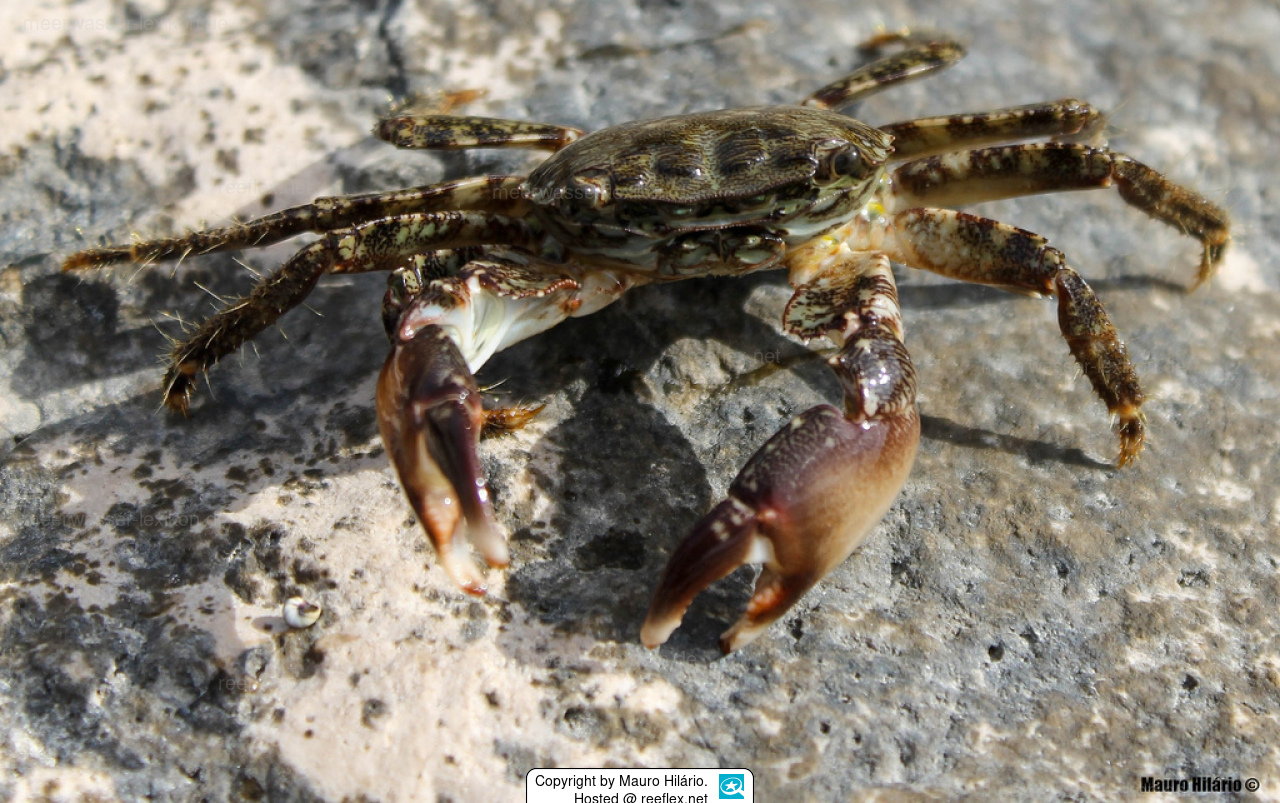Info
(Fabricius, 1787)
Common in Mediterranean Sea, in Atlantic Ocean (coasts of France and Morocco).
It can resist long periods out of the water. It is very fast in movements, this is why it is also called "running crab".
Synonyms:
Cancer femoralis Olivier, 1791
Cancer marmoratus Fabricius, 1787
Grapsus (Grapsus) savignyi De Haan, 1835
Grapsus varius Latreille, 1803
Leptograpsus bertheloti H. Milne Edwards, 1853
Pachygrapsus pubescens Heller, 1865
am 08.04.15#2
Diese Krabben sind wirklich hübsch und interessant. Ich habe mir eine mit dem Lebendgestein "eingefangen" (bewusst hätte das wohl kaum geklappt), sie ist kontinurielich gewachsen und hat mich am Anfang mit ihrem Algenknabbern sehr erfreut. Mittlerweile ist sie fast ausgewachsen und es ist glaub ich Zeit, dass sich unsere Wege trennen: sämtliche Athanas-garnelen sind verschwunden, eine Felsengarnele und an der Röhre des Protula intestinum wird auch "gearbeitet" - da ich kein anderes Tier im Aquarium habe, das zu sowas fähig wäre verdächtige ich natürlich die Krabbe... Aufgrund der Grösse eigentlich perfekt für Aquarien, aber leider nicht "kompatibel" genug.
am 05.10.10#1
Hallo erstmal.
Wahrscheinlich hat jeder schon mal im Urlaub (zum Beispiel in Kroatien) diese Krabben am Meer auf den Klippen beobachtet. Und Viele Aquarianer hier waren wie ich sicher von ihrer Lebensweise und Gruppenverhalten beeindruckt. Es macht wirklich spaß ihnen bei der Futtersuche in der Brandungszone zuzuschauen.
Und jetzt habe ich seit einem halben Jahr selbst eine kleine Gruppe und möchte mal meine bisherigen Erfahrungen mitteilen ;)
Zum Aquarium:
Sie sind definitiv nicht für das tropische Korallenaquarium geeignet. Allein schon, weil sie sehr gute Ausbruchskünstler sind und unbedingt einen Landteil zur Verfügung haben müssen. Ob sie Korallen, Anemonen und andre Tiere schädigen würden weiß ich aber nicht, kann es mir aber gut vorstellen..
Bei mir leben 3 Weibchen, 1 Männchen und ein Jungtier in einem zur hälfte gefüllten 45L Aquarium.
Technik:
An Technik braucht diese sehr toleranten Krabbe nicht viel. Höchstens eine pumpe um das Wasser in Bewegung zu halten. Auf Beleuchtung kann man komplett verzichten, ich würde aber empfehlen das Aquarium so aufzustellen, das sie sich zeitweise in der Sonne aufwärmen können (was sie seehr gerne machen.)
Futter:
Die Krabben fressen so gut wie alles, was ihnen in die Scheren kommt. Fisch, Garnelen, Frost und Trockenfutter wird alles problemlos angenommen. Auch Fadenalgen und Caulerpas können gefüttert werden.
verhalten:
Ganz wichtig ist, das in einem Becken nur ein Männchen mit mehreren Weibchen ist, da es sonst Revierkämpfe auf der kleinen Fläche gibt, die eines der Tiere nicht überleben wird. Ansonsten sind sie untereinander sehr friedlich und es gibt kaum Streitereien. Was mir aufgefallen ist, is das kleine Krabben sehr schnell zutraulich werden und einem beim Füttern sogar schon auf die Hand springen um so schnell wie möglich an ihr Futter zu kommen. Die größeren zutraulich zu bekommen ist dagegen schon etwas schwieriger. Zwar verlieren auch sie sehr schnell die angst, halten aber trotzdem immer einen Sicherheitsabstand ein.
Es sind wirklich sehr interessante Tiere, die keinerlei Probleme machen (wenn das Becken ausbruchssicher ist ;) ) und auch keine hohen Ansprüche an die Wasserqualität haben. Von dem her kann ich sie für jeden interessierten empfehlen, der sich ein separates Aquarium einrichten möchte.







 Mauro Hilário
Mauro Hilário




















